
A Manhattan is a cocktail made with whiskey, sweet vermouth, and bitters. While rye is the traditional whiskey of choice, other commonly used whiskies include Canadian whisky, bourbon, blended whiskey, and Tennessee whiskey. The cocktail is usually stirred then strained into a cocktail glass and garnished traditionally with a maraschino cherry. A Manhattan may also be served on the rocks in a lowball glass.

Vermouth is an aromatized fortified wine, flavoured with various botanicals and sometimes colored. The modern versions of the beverage were first produced in the mid to late 18th century in Turin, Italy. While vermouth was traditionally used for medicinal purposes, it was later served as an apéritif, with fashionable cafés in Turin serving it to guests around the clock. In the late 19th century, it became popular with bartenders as a key ingredient for cocktails, such as the martini, the Manhattan, the Rob Roy, and the Negroni. In addition to being consumed as an aperitif or cocktail ingredient, vermouth is sometimes used as an alternative to white wine in cooking.

The martini is a cocktail made with gin and vermouth, and garnished with an olive or a lemon twist. Over the years, the martini has become one of the best-known mixed alcoholic beverages. A popular variation, the vodka martini, uses vodka instead of gin for the cocktail's base spirit.
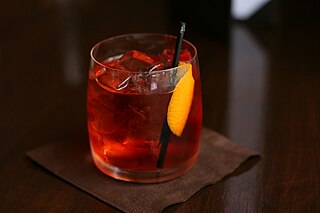
A Negroni is an Italian cocktail, made of one part gin, one part vermouth rosso and one part Campari, garnished with orange peel. It is considered an apéritif.
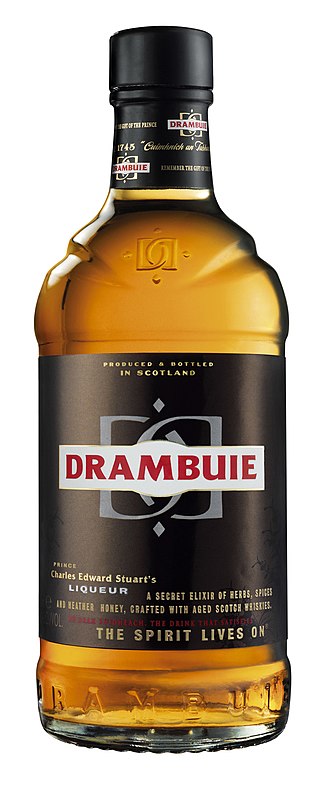
Drambuie is a golden-coloured, 40% ABV liqueur made from Scotch whisky, heather honey, herbs and spices. The brand was owned by the MacKinnon family for 100 years, and was bought by William Grant & Sons in 2014.
Dryness is a property of beverages that describes the lack of a sweet taste. This may be due to a lack of sugars, the presence of some other taste that masks sweetness, or an underabundance of simple carbohydrates that can be converted to sugar by enzymes in the mouth. The term "dry" may be applied to types of beer, wine, cider, distilled spirits, or any other beverage.

A rusty nail is a cocktail made by mixing Scotch whisky with Drambuie in a 1:1 to 2:1 ratio. A rusty nail is most commonly served on the rocks in an old-fashioned glass, although it can also be served "up" in a stemmed glass. Its origin goes back to the 1937 British Industries Fair, but it did not become popular until the 1950s endorsement by New York's Club 21 and its recognition by popular culture as the go-to cocktail of the Rat Pack a decade later.
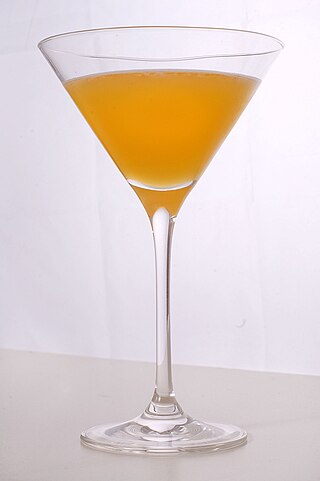
The Bronx is a cocktail. It is essentially a Perfect Martini with orange juice added. It was ranked number three in "The World's 10 Most Famous Cocktails in 1934" behind the Martini (#1) and the Manhattan (#2). In the 1934 movie "The Thin Man", the lead actor compared the methods for shaking the Manhattan, the Bronx and the Martini.

The Fine Art of Mixing Drinks is a book about cocktails by David A. Embury, first published in 1948. The book is noteworthy for its witty, highly opinionated and conversational tone, as well as its categorization of cocktails into two main types: aromatic and sour; its categorization of ingredients into three categories: the base, modifying agents, and special flavorings and coloring agents; and its 1:2:8 ratio for sour type cocktails.

A "fizz" is a mixed drink variation on the older sours family of cocktail. Its defining features are an acidic juice and carbonated water. It typically includes gin or rum as its alcoholic ingredient.

The Bobby Burns is a whisky cocktail composed of scotch, vermouth and Bénédictine liqueur. It is served in a 4.5 US fl oz cocktail glass.
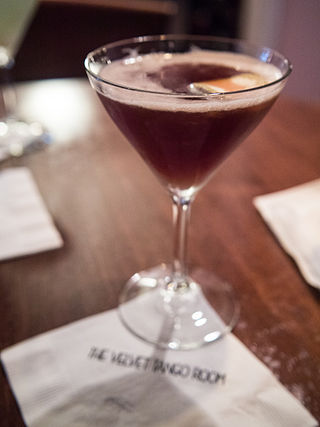
Blood and Sand is one of the few classic mixed drinks that includes Scotch whisky. It was named after Rudolph Valentino's 1922 bullfighter movie Blood and Sand. The red juice of the blood orange in the drink helped link it with the film. The recipe is first known to have appeared in the 1930 Savoy Cocktail Book.
Rob Roy is an operetta by composer Reginald De Koven and lyricist Harry B. Smith, frequent collaborators, loosely based upon the life of Scottish folk hero Robert Roy MacGregor, better known as Rob Roy, and the Walter Scott novel about him.
An aromatised wine is a fortified wine or mistelle that has been flavoured with herbs, spices, fruit or other natural flavourings.
The Blackthorn is an Irish whiskey or sloe gin based cocktail. Both versions emerged in the late 19th and early 20th century.

The Martinez is a classic cocktail that is widely regarded as the direct precursor to the Martini. It serves as the basis for many modern cocktails, and several different versions of the original exist. These are generally distinguished by the accompaniment of either Maraschino or Curacao, as well as differences in gin or bitters.
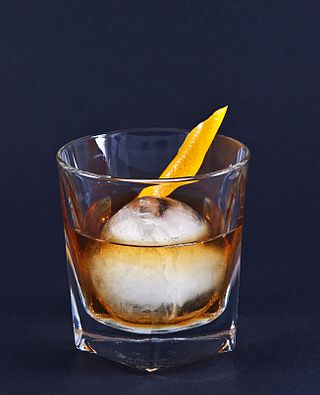
A whiskey cocktail is a cocktail that includes whiskey. Although whiskey is often served neat or on the rocks, it is used in many classic cocktails such as the Old Fashioned, Manhattan, and Julep. Some specifically call for Scotch whisky or bourbon whiskey.














